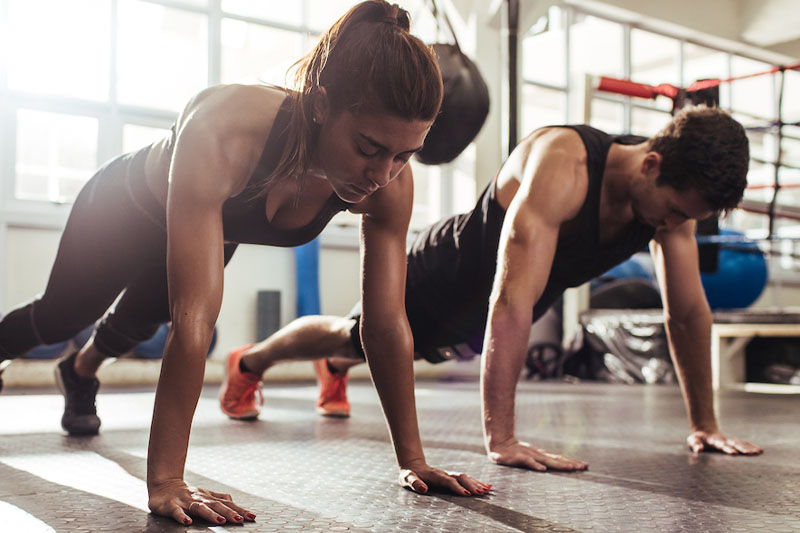Push-ups are a timeless and highly effective bodyweight exercise that have stood the test of time for good reason. They offer a multitude of benefits, engage various muscle groups, and can be adapted for all fitness levels. In this article, we’ll delve into the advantages of push-ups, explore different variations, understand the muscles they target, learn how to perfect your technique, and offer a beginner’s guide to starting your push-up journey.
The Benefits of Push-Ups
Push-ups are a versatile exercise that provides numerous advantages:
- Strength Building: Push-ups are a great way to build upper body strength, working muscles like the chest, shoulders, and triceps.
- Convenience: You can do push-ups almost anywhere, making them a convenient choice for home workouts or when you’re on the go.
- Cost-Effective: No equipment is required, making push-ups a cost-effective exercise.
- Core Engagement: Push-ups engage the core muscles, helping to improve stability and posture.
- Muscle Balance: They promote muscle balance by working the chest, shoulders, and triceps, helping to prevent muscle imbalances.
Variations of Push-Ups
- Standard Push-Up: Place your hands slightly wider than shoulder-width apart and lower your body by bending your elbows, then push back up.
- Wide-Arm Push-Up: Place your hands wider apart to engage the chest muscles more.
- Diamond Push-Up: Form a diamond shape with your thumbs and index fingers under your chest. This variation emphasizes the triceps.
- Decline Push-Up: Elevate your feet on a platform or bench to increase the difficulty and work the upper chest.
- Incline Push-Up: Place your hands on an elevated surface to ease the exercise while targeting the lower chest.
- One-Arm Push-Up: A more advanced move, where one arm remains close to your body while the other extends to perform the push-up.
Muscles Targeted by Push-Ups
Push-ups engage several muscle groups:
- Chest: The primary muscle group targeted, especially in the standard push-up.
- Shoulders: The anterior deltoids are heavily engaged.
- Triceps: These muscles are crucial for elbow extension during the push-up.
- Core: Your core muscles stabilize your body during the exercise.
- Back: The rhomboids and trapezius assist in scapular stabilization.
Perfecting Your Push-Up Technique
To ensure you’re performing push-ups correctly:
- Body Alignment: Maintain a straight line from your head to your heels. Avoid sagging your hips or raising your butt.
- Hand Placement: Position your hands slightly wider than shoulder-width apart.
- Elbow Position: Keep your elbows close to your body as you lower yourself to the ground.
- Range of Motion: Aim for a full range of motion, lowering your chest to just above the ground.
- Breathing: Inhale as you lower your body and exhale as you push back up.
Getting Started with Push-Ups
If you’re new to push-ups, here’s a step-by-step guide to help you get started:
- Wall Push-Up: Begin with wall push-ups, where you stand facing a wall and push against it at a slight angle.
- Incline Push-Up: Perform push-ups with your hands on an elevated surface, like a bench or a sturdy table.
- Knee Push-Up: Lower your knees to the ground while keeping your body in a straight line.
- Standard Push-Up: Gradually work your way up to standard push-ups as your strength improves.
A Complete Push-Up Workout
Here’s a sample push-up workout to get you started:
Warm-up: 5 minutes of light cardio (e.g., jumping jacks or jogging in place)
Circuit (Repeat 3 Times):
- Wall Push-Ups: 10 reps
- Incline Push-Ups: 8 reps
- Knee Push-Ups: 6 reps
- Standard Push-Ups: 4 reps
Cool-down: 5-10 minutes of stretching to improve flexibility and reduce muscle tension.
Push-ups can be tailored to your fitness level, making them accessible and effective for everyone. Incorporate them into your regular exercise routine, focusing on proper technique and gradually progressing to more advanced variations. With time and consistency, you’ll reap the many benefits of this timeless and versatile exercise.

